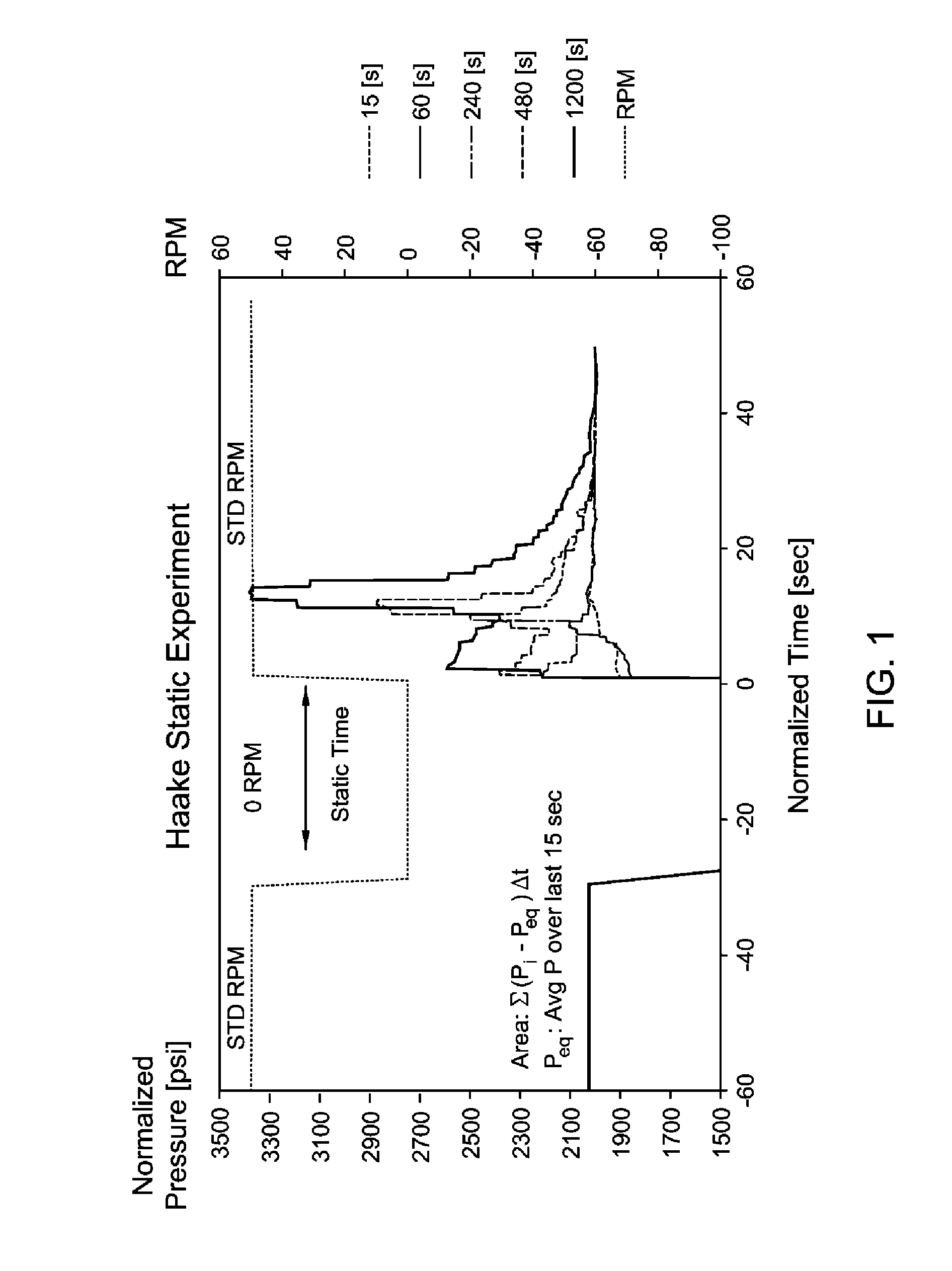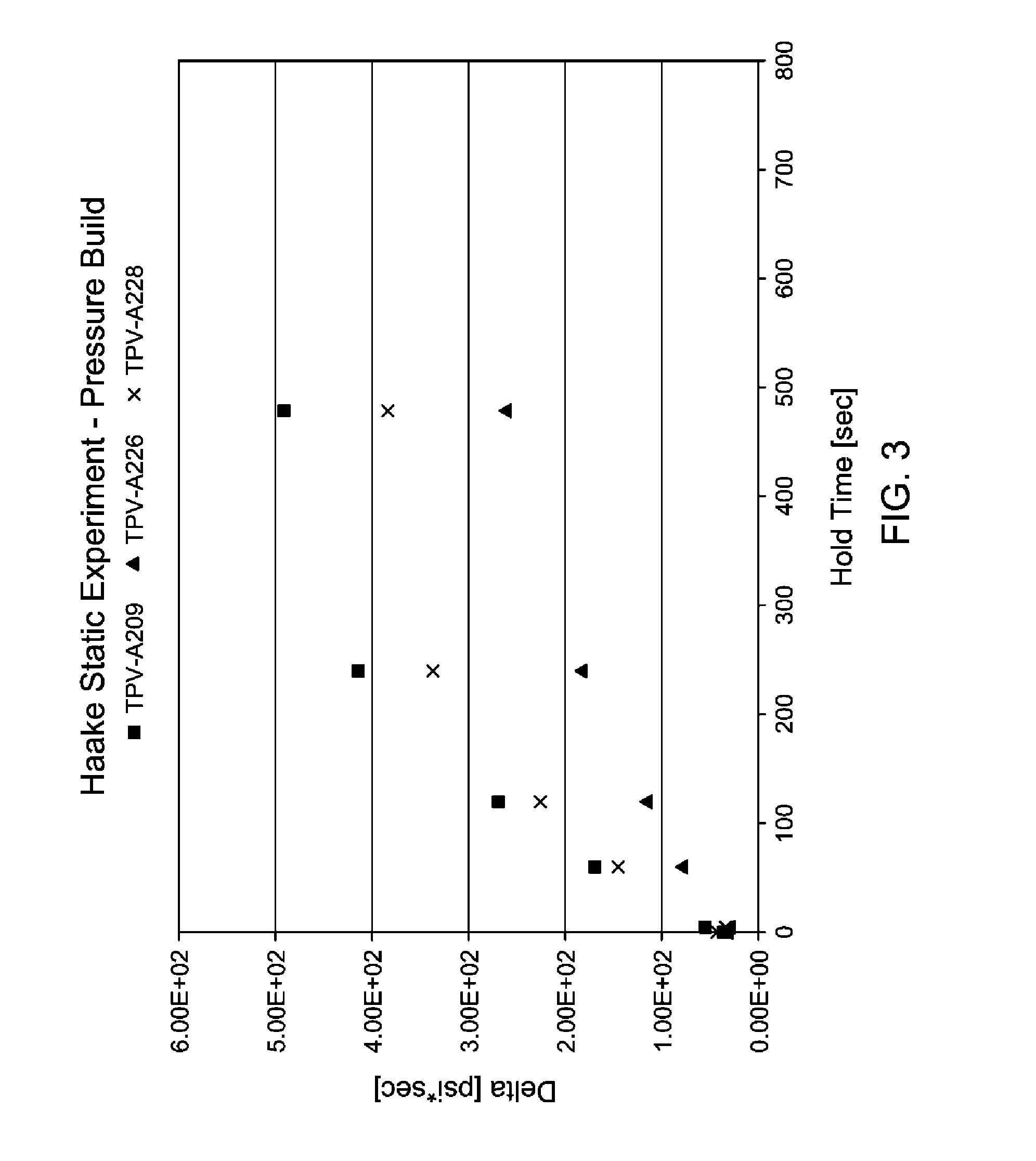Thermoplastic Vulcanizates Comprising Propylene-Based Elastomers and Methods for Making the Same
a technology of vulcanizate and elastomer, which is applied in the field of thermoplastic vulcanizate comprising propylene-based elastomers and methods for making the same, can solve the problems of inability to meet the requirements of many end-use applications, flow marks on the surface of injection molded articles, and surface imperfections on extruded profiles, so as to improve surface quality and extrusion processability.
- Summary
- Abstract
- Description
- Claims
- Application Information
AI Technical Summary
Benefits of technology
Problems solved by technology
Method used
Image
Examples
example 1
[0143]TPVs were prepared by dynamically mixing and vulcanizing in a twin-screw extruder the formulations described in Tables 1A and 1B. The formulations in Tables 1A and 1B describe the amount of each ingredient in the formulation as parts per hundred parts of rubber (“phr”). Certain physical properties of the TPV are also listed in Tables 1A and 1B.
[0144]Tables 2A and 2B list the formulations from Tables 1A and 1B by the weight percent of each material type, e.g., rubber, thermoplastic resin, etc., in the thermoplastic vulcanizate, where the weight percent of the material type was calculated using the ingredients in Tables 1A and 1B.
[0145]Tables 3A and 3B show the relative contribution of the main components to the continuous phase. Thus, Tables 3A and 3B show the relative amounts of each polypropylene (that was not part of a masterbatch) and the PBEs in the continuous phase of the TPV.
[0146]The thermoplastic resin, PBE, granulated rubber, clay, zinc oxide, SnCl2 masterbatch, and c...
example 2
[0159]In Example 2, an additional Haake Static Experiment was undertaken using TPVs having the formulations of Example 1. The Haake Static Experiment of Example 2 took place according to the same method as described with reference to Example 1, except that the extruder zone temperatures were increased as compared to Example 1. Instead of the extruder zone temperatures described in Example 1, in Example 2 the extruder zone temperatures were set to 180° C. (Zone 1), 200° C. (Zone 2), 200° C. (Zone 3), 200° C. (Die).
[0160]The changes in the pressure build in the Haake Static Experiment in Example 2 are shown in FIGS. 4 and 5. The reduction of the pressure build delta seen in Example 1 was not seen for all of the TPV samples in FIGS. 4 and 5 at the higher extrusion temperatures used in Example 2. However, as seen in FIG. 6, the TPVs containing the PBE tended to have a decreased peak pressure spike during the Haake Static Experiment as compared to the control TPV-A210 (particularly at lo...
example 3
[0161]TPVs were prepared by dynamically mixing and vulcanizing in a twin-screw extruder the formulations described in Table 8 using a process similar to that of Example 1. As compared to the process of Example 1, the extruder used in Example 3 had a diameter that was approximately 2.2 times the diameter of the extruder used in Example 1, and the extrusion temperatures were adapted to adjust for the larger extruder diameter. Like in Example 1, the thermoplastic resin, PBE, granulated rubber, clay, zinc oxide, SnCl2 masterbatch, and carbon black masterbatch were added to the extruder at the feed throat. The phenolic resin-in-oil was injected into the extruder after the feed throat and initial mixing zone. A first portion (“Oil #3”) of the free oil was introduced to the extruder after the feed throat but before the phenolic resin-in-oil injection point and a second portion (“Oil #4”) of the free process oil was introduced to the extruder after the phenolic resin-in-oil injection point....
PUM
| Property | Measurement | Unit |
|---|---|---|
| melt flow rate | aaaaa | aaaaa |
| wt % | aaaaa | aaaaa |
| melt temperature | aaaaa | aaaaa |
Abstract
Description
Claims
Application Information
 Login to View More
Login to View More - R&D
- Intellectual Property
- Life Sciences
- Materials
- Tech Scout
- Unparalleled Data Quality
- Higher Quality Content
- 60% Fewer Hallucinations
Browse by: Latest US Patents, China's latest patents, Technical Efficacy Thesaurus, Application Domain, Technology Topic, Popular Technical Reports.
© 2025 PatSnap. All rights reserved.Legal|Privacy policy|Modern Slavery Act Transparency Statement|Sitemap|About US| Contact US: help@patsnap.com



